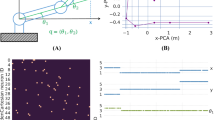Abstract
How can we build robot controllers that are able to work under harsh conditions, but without experiencing catastrophic failures? As seen on the recent Fukushima’s nuclear disaster, standard robots break down when exposed to high radiation environments. Here we present the results from two arrangements of Spiking Neural Networks, based on the Liquid State Machine (LSM) framework, that were able to gracefully degrade under the effects of a noisy current injected directly into each simulated neuron. These noisy currents could be seen, in a simplified way, as the consequences of exposition to non-destructive radiation. The results show that not only can the systems withstand noise, but one of the configurations, the Modular Parallel LSM, actually improved its results, in a certain range, when the noise levels were increased. Also, the robot controllers implemented in this work are suitable to run on a modern, power efficient neuromorphic hardware such as SpiNNaker.
Access this chapter
Tax calculation will be finalised at checkout
Purchases are for personal use only
Similar content being viewed by others
Notes
- 1.
Source code available at github.com/ricardodeazambuja/IJCNN2016.
References
de Azambuja, R., Cangelosi, A., Adams, S.: Diverse, noisy and parallel: a new spiking neural network approach for humanoid robot control. In: 2016 International Joint Conference on Neural Networks (IJCNN). p. In Press (In Press)
Benito-Len, J., Louis, E.D.: Essential tremor: emerging views of a common disorder. Nat. Clin.l Pract. Neurol. 2(12), 666–678 (2006)
Chowdhury, F.K., Choe, D., Jevremovic, T., Tabib-Azar, M.: Design of MEMS based XOR and AND gates for rad-hard and very low power LSI mechanical processors. In: 2011 IEEE Sensors, pp. 762–765, October 2011
Flash, T., Hogan, N.: The coordination of arm movements: an experimentally confirmed mathematical model. J. Neurosci. 5(7), 1688–1703 (1985)
Furber, S.B., Lester, D.R., Plana, L.A., Garside, J.D., Painkras, E., Temple, S., Brown, A.D.: Overview of the SpiNNaker system architecture. IEEE Trans. Comput. 62(12), 2454–2467 (2013)
Herculano-Houzel, S.: Scaling of brain metabolism with a fixed energy budget per neuron: implications for neuronal activity, plasticity and evolution. PLoS One 6(3), e17514 (2011)
Indiveri, G., Linares-Barranco, B., Hamilton, T.J., van Schaik, A., Etienne-Cummings, R., Delbruck, T., Liu, S.C., Dudek, P., Hfliger, P., Renaud, S., Schemmel, J., Cauwenberghs, G., Arthur, J., Hynna, K., Folowosele, F., Saïghi, S., Serrano-Gotarredona, T., Wijekoon, J., Wang, Y., Boahen, K.: Neuromorphic silicon neuron circuits. Neuromorphic Eng. 5, 73 (2011)
Joshi, P., Maass, W.: Movement generation with circuits of spiking neurons. Neural Comput. 17(8), 1715–1738 (2005)
Kandil, M.R., Tohamy, S.A., Abdel Fattah, M., Ahmed, H.N., Farwiez, H.M.: Prevalence of chorea, dystonia and athetosis in assiut, egypt: a clinical and epidemiological study. Neuroepidemiology 13(5), 202–210 (1994)
Kaul, H., Anders, M., Hsu, S., Agarwal, A., Krishnamurthy, R., Borkar, S.: Near-threshold voltage (NTV) design: opportunities and challenges. In: Proceedings of the 49th Annual Design Automation Conference, pp. 1153–1158. ACM (2012)
Kerns, S.E., Shafer, B.D., van Vonno, N., Barber, F.E.: The design of radiation-hardened ICs for space: a compendium of approaches. Proc. IEEE 76(11), 1470–1509 (1988)
Kogge, P., Bergman, K., Borkar, S., Campbell, D., Carlson, W., Dally, W., Denneau, M., Franzon, P., Harrod, W., Hill, K., Hiller, J., Karp, S., Keckler, S., Klein, D., Lucas, R., Richards, M., Scarpelli, A., Scott, S., Snavely, A., Sterling, T., Williams, R.S., Yelick, K.: ExaScale computing study: technology challenges in achieving exascale systems. Technical report University of Notre Dame, September 2008
Maass, W.: Noise as a resource for computation and learning in networks of spiking neurons. Proc. IEEE 102(5), 860–880 (2014)
Maass, W., Joshi, P., Sontag, E.D.: Computational aspects of feedback in neural circuits. PLoS Comput. Biol. 3(1), e165 (2007)
Maass, W., Natschlger, T., Markram, H.: Real-time computing without stable states: a new framework for neural computation based on perturbations. Neural Comput. 14(11), 2531–2560 (2002)
Rogers, T.T., McClelland, J.L.: Parallel distributed processing at 25: further explorations in the microstructure of cognition. Cogn. Sci. 38(6), 1024–1077 (2014)
Rohmer, E., Singh, S.P., Freese, M.: V-REP: A versatile and scalable robot simulation framework. In: 2013 IEEE/RSJ International Conference on Intelligent Robots and Systems (IROS), pp. 1321–1326. IEEE (2013)
Roy, D.S., Arons, A., Mitchell, T.I., Pignatelli, M., Ryan, T.J., Tonegawa, S.: Memory retrieval by activating engram cells in mouse models of early Alzheimers disease. Nature 531(7595), 508–512 (2016)
Ryan, T.J., Roy, D.S., Pignatelli, M., Arons, A., Tonegawa, S.: Engram cells retain memory under retrograde amnesia. Science 348(6238), 1007–1013 (2015)
Sakoe, H., Chiba, S.: Dynamic programming algorithm optimization for spoken word recognition. IEEE Trans. Acoust. Speech Signal Process. 26(1), 43–49 (1978)
Schemmel, J., Brderle, D., Grbl, A., Hock, M., Meier, K., Millner, S.: A wafer-scale neuromorphic hardware system for large-scale neural modeling. In: Proceedings of the 2010 IEEE International Symposium on Circuits and Systems (ISCAS 2010), pp. 1947–1950 (2010)
Vertrees, S.M., Berman, S.A.: Chorea in adults: background, pathophysiology, epidemiology. http://emedicine.medscape.com/article/1149854-overview. Accessed: 19 Apr 2016
Waldrop, M.M.: More than moore. Nature 530(7589), 114 (2016)
Acknowledgment
This work was in part supported by the CAPES Foundation, Ministry of Education of Brazil (scholarship BEX 1084/13-5), CNPq Brazil (scholarship 232590/2014-1) and UK EPSRC project BABEL (EP/J004561/1 and EP/J00457X/1).
Author information
Authors and Affiliations
Corresponding author
Editor information
Editors and Affiliations
Rights and permissions
Copyright information
© 2016 Springer International Publishing AG
About this paper
Cite this paper
de Azambuja, R., Klein, F.B., Stoelen, M.F., Adams, S.V., Cangelosi, A. (2016). Graceful Degradation Under Noise on Brain Inspired Robot Controllers. In: Hirose, A., Ozawa, S., Doya, K., Ikeda, K., Lee, M., Liu, D. (eds) Neural Information Processing. ICONIP 2016. Lecture Notes in Computer Science(), vol 9947. Springer, Cham. https://doi.org/10.1007/978-3-319-46687-3_21
Download citation
DOI: https://doi.org/10.1007/978-3-319-46687-3_21
Published:
Publisher Name: Springer, Cham
Print ISBN: 978-3-319-46686-6
Online ISBN: 978-3-319-46687-3
eBook Packages: Computer ScienceComputer Science (R0)




